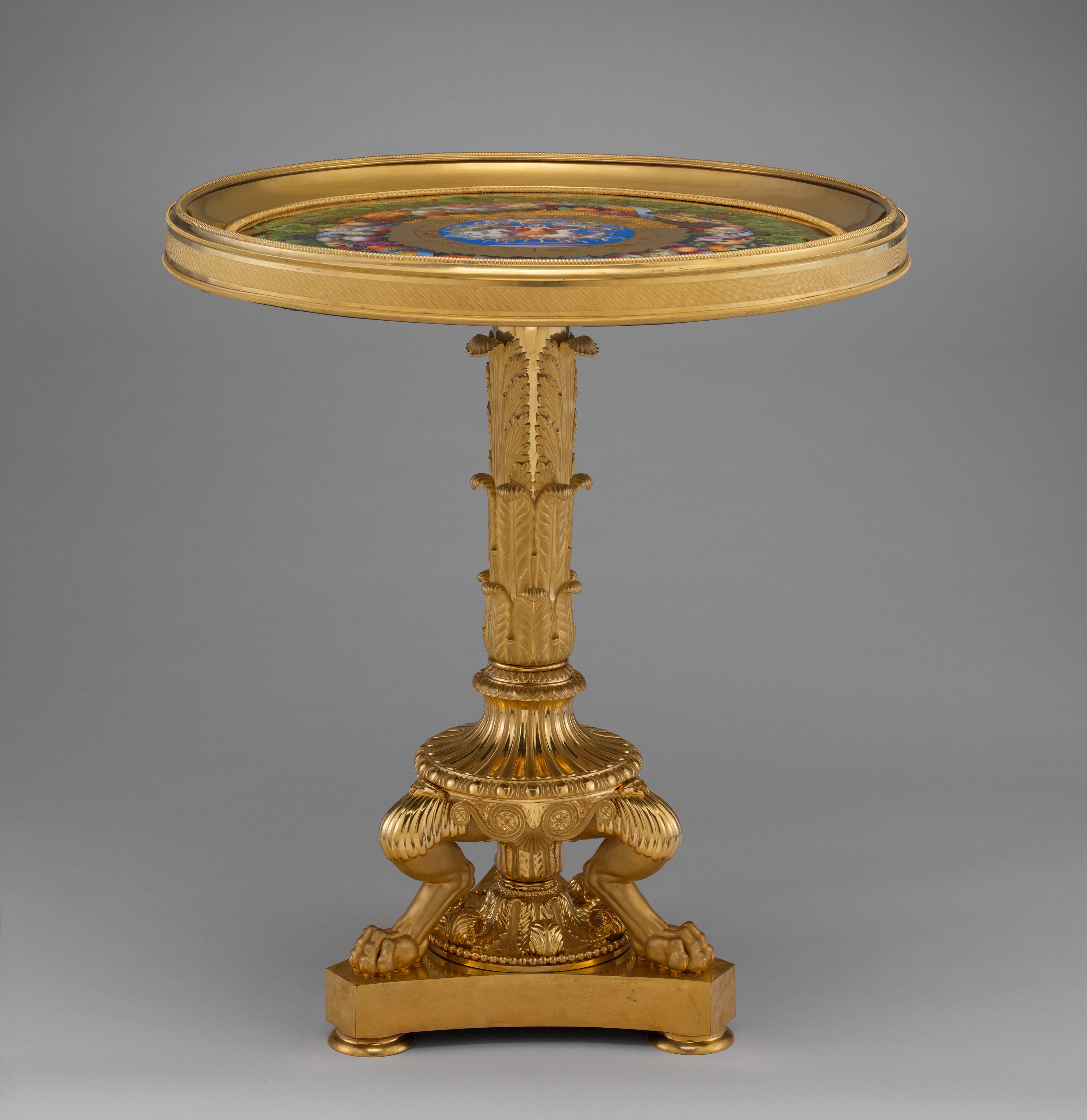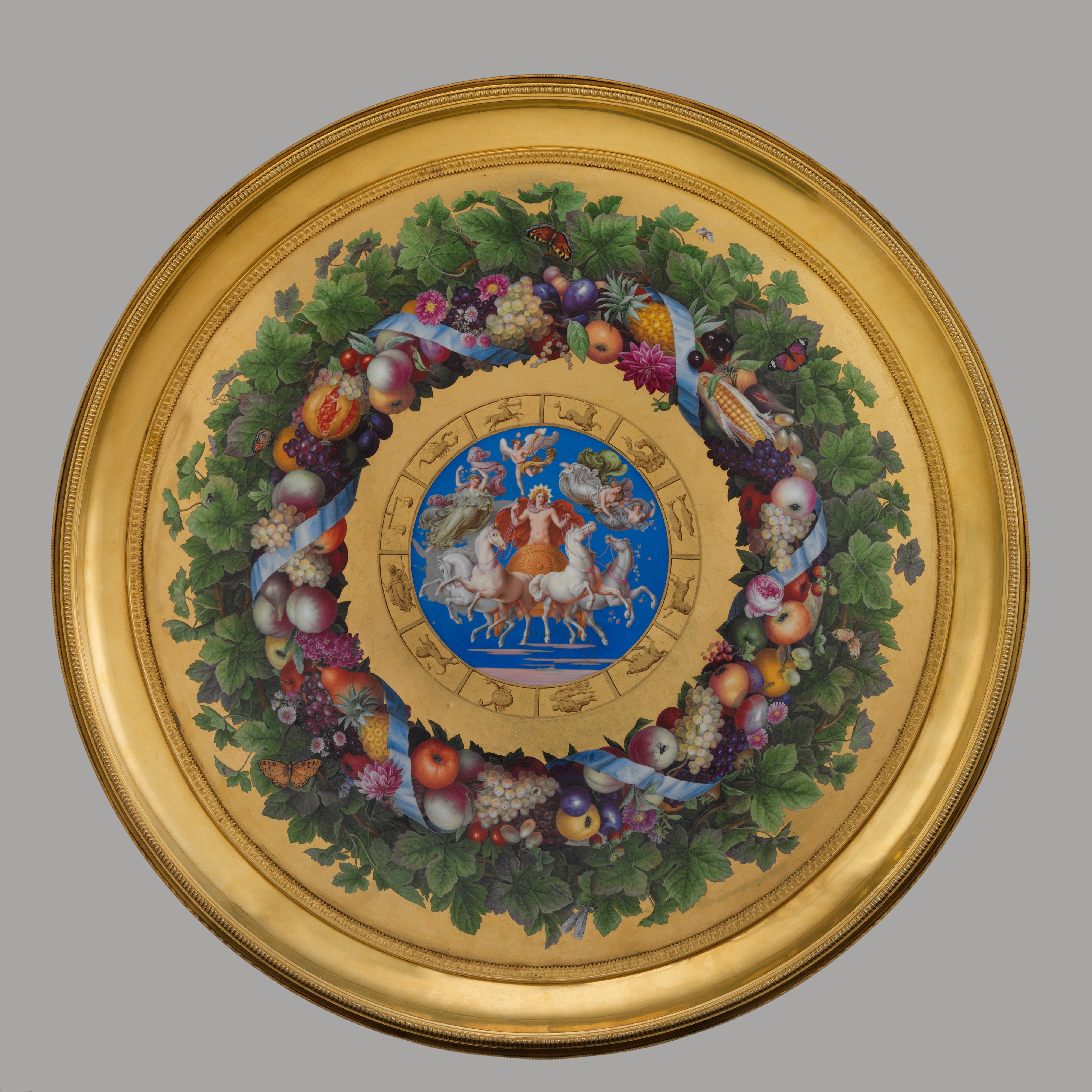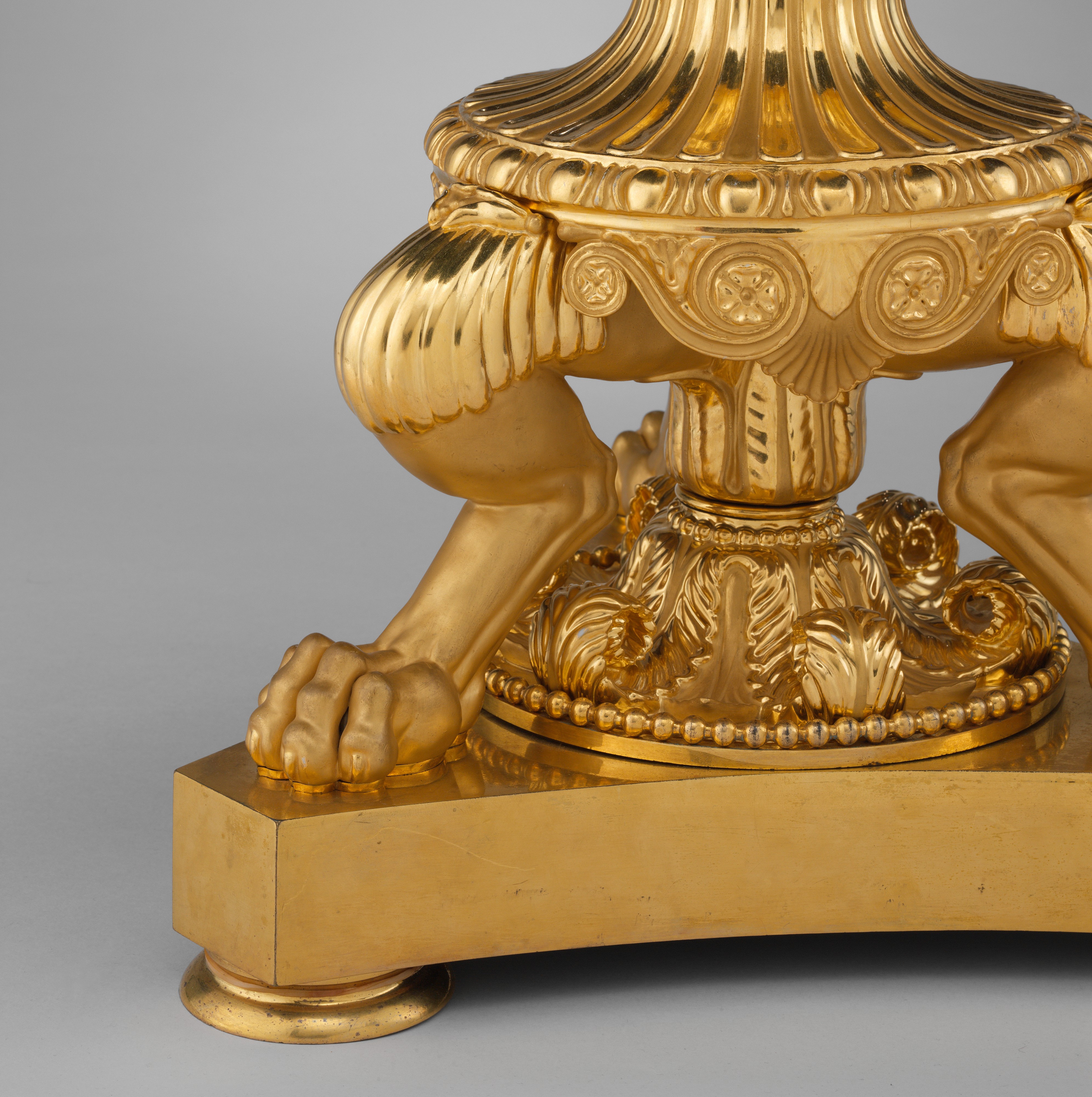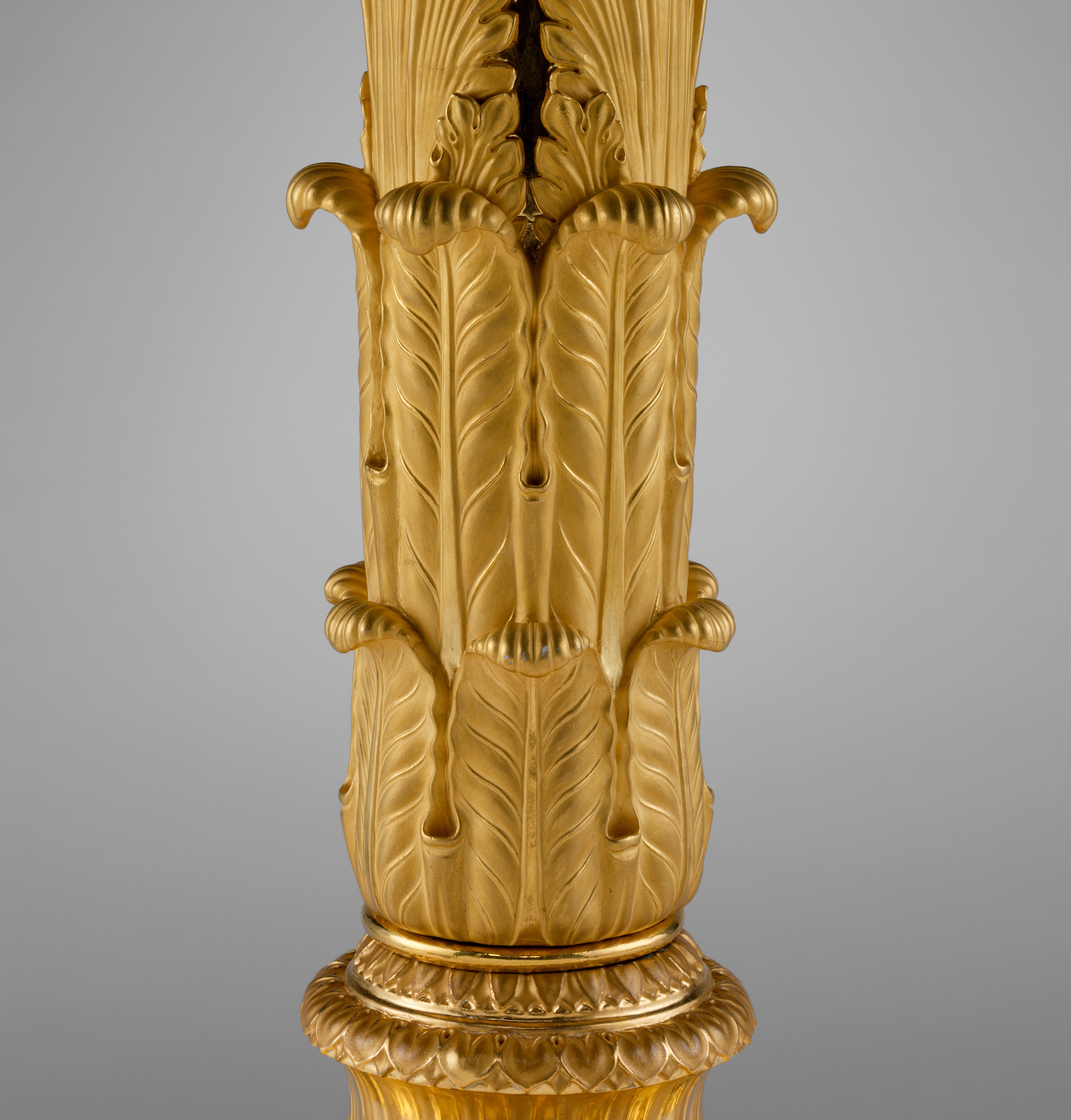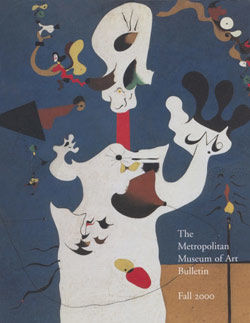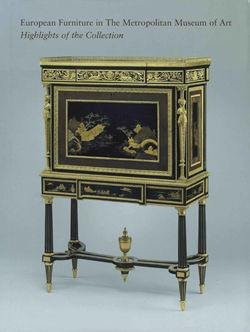Table
This dazzling table is made entirely of porcelain with the exception of the reeded gilt-metal rim with concave moldings around the circular porcelain top, the canted triangular gilt-metal base with low feet, and the gilt-bronze beaded molding encircling the porcelain curling-leaf decoration on top of the base. There is also an iron column that acts as a spine, disguised by four porcelain acanthus-leaf sleeves fitted one above the other, set off by gilded metal moldings. The gilding of the porcelain surface of the stand is daringly finished in different techniques that create delicate matt and brightly polished areas, producing the trompe l'oeil effect of a gilded cast-bronze support.[1]
The fabrication of the Museum's spectacular table was made possible by new production and color technologies that were developed after 1832 at the Royal Porcelain Manufactory, Berlin, to attract royal patronage.[2] The catalogue of the Academy Exhibition of 1834 mentions "a round table with porcelain top and porcelain foot."[3] Since porcelain tabletops were usually fitted with supports of metal or carved wood, this piece would have been a novelty and of great interest to the public. A Berlin newspaper devoted much space to the subject in November of that year: "The porcelain table with a twenty-six-inch circular top displayed at the current exhibition in the rooms of the Royal Academy is characterized not only by excellent color, gilding, and painting but by a beautifully smooth top . . . [and this] can also be said of the gilded table foot. Only the triangular base of the piece is of gilded bronze: all other [parts], even those that are difficult to make, such as the ancient griffins feet, are of porcelain, and [they] testify to the skill of the modelers employed by the manufactory, and to their good fortune in overcoming the difficulties encountered during the firing of the porcelain."[4]
It is tempting to identify the table mentioned in the Berlinische Nachrichten with the Museum's example. Very likely only two tables of this size with a porcelain foot were produced at the manufactory. One was given by King Frederick William III of Prussia (1770–1840) to the grand duchess of Weimar in 1838. It is described in the king's privy-purse account as having a "top 25 inches in diameter on a porcelain foot with figural painting."[5] The same account book, which the king began to keep in 1811 to record royal gifts within his family (and their value) as well as diplomatic presents to foreign dignitaries, mentions in much more detail an earlier gift by the monarch to Grand Duchess Helena Pavlovna of Russia (1807–1873). In an entry of 1 June 1835, the Museum's table is described as follows: "For Her Royal Highness the Grand Duchess Helene, 1. Tabletop, circular, 25 inches in diameter, with colored figures, the subject Helios, on a blue background, surrounded by a zodiac border in brown and gold on matt gold, the whole background polished gold, on which colored fruits and flower garlands are intertwined with a blue band, also colored butterflies and insects."[6] The price (1,200 taler) was very high, surpassed only by that of the monumental vases the king commissioned as gifts for the Russian court.[7] The top is richly decorated with a central tondo in which Helios, the sun god, is seen rising up to heaven from the eastern Ocean in a carriage pulled by four white horses. "Iconographically the signs of the . . . zodiac [in the band around the tondo] belong to the triumph of light during the course of the seasons."[8] The latter are represented by garlands of the fruits and flowers that flourish as the year progresses, and these are displayed on a wreath of vine leaves, autumn's bounty. The exotic fruits, such as pineapples and pomegranates, possibly symbolize winter, when they would have been cultivated in the fashionable and expensive greenhouses of the period, a luxury as extravagant as a table made almost completely out of porcelain.
As unusual as this lavish present was the character of the recipient, Helena Pavlovna. Born Princess Charlotte of Württemberg, she married, in 1824, Grand Duke Michael Pavlovitch, the youngest brother of Alexander I of Russia (1777–1825). She was one of the most fascinating personalities of the period, always a little ahead of her time. Socially and politically concerned with Russia's future, she was a most outspoken advocate of the abolition of serfdom, setting a courageous example on her own estates. In 1859, two years before Alexander II (1818–1881) officially abolished serfdom, the grand duchess freed more than fifteen thousand people living on her estates in the Ukraine.[9] During the Crimean War, this mother of five daughters established a nursing unit, a step that was aggressively opposed by leading military figures. This was the first war in which medically trained women served on the battle field, saving the lives of thousands of soldiers. The salon of her residence, the Mikhail Palace–designed by Karl Rossi (1775–1849) and the finest example of architecture in the Russian Empire style–was one of the cultural centers of Saint Petersburg. The palace now houses the State Russian Museum. Beginning in 1852, the gifted pianist Anton Rubinstein (1829–1894) was part of the grand duchess's artistic entourage. She firmly supported Rubinstein's ambition to found Russia's first musical conservatory, whose most famous student would be the composer Peter Ilyich Tchaikovsky (1840–1893).[10]
The Museum's table can be attributed to Karl Friedrich Schinkel, Germany's most important nineteenth-century architect, who was also a gifted interior designer (see 1996.30). Schinkel's tables are distinguished by their strong compositions and inventive interpretations of ancient models, especially the tripod form.[11] Closely related shaft designs with highly stylized acanthus leaves arranged in tiers can be seen on the monumental candelabra of 1831–32 in the Schinkel Pavilion at Schloss Charlottenburg, Berlin.[12] It seems that during this period in Berlin only Schinkel could coordinate many different craftsmen in the production of a large and complex object that looks magnificent when seen from a distance and withstands the close scrutiny of a connoisseur in its refined details. These qualities, rarely seen in furniture, characterize this extraordinary table.
[Wolfram Koeppe 2006]
Footnotes:
1. See "Recent Acquisitions: A Selection, 1999–2000." The Metropolitan Museum of Art Bulletin 58, no. 2 (Fall 2000), pp. 40-41 (entry by Clare Le Corbeiller); and Ilse Baer. "Table Tops from the Berlin Porcelain Manufactory (KPM) from the First Half of the Nineteenth Century." In The International Ceramics Fair and Seminar Handbook, 2001, pp. 17–18, fig. 9.
2. Georg Kolbe. Geschichte der Königlichen Porcellanmanufactur zu Berlin nebst einer einleitenden Übersicht der geschichtlichen Entwickelung der ceramischen Kunst. Berlin, 1862, p. 254
3. "Ein runder Tisch mit Porzellan Platte und Fuss." Helmut Börsch-Supan, ed. Die Kataloge der Berliner Akademie-Ausstellungen, 1786–1850. 2 vols. Quellen und Schriften zur bildenden Kunst 4. Berlin, 1971, vol. 2, no. 1164 (for 1834).
4. "Schon der auf der irzigen Ausstellung in den Sälen der k. Akademie aufgestellte Porzellan-Tisch mit einer runden Tischplatte von sechs und zwanzig Zoll Durchmesser, zeichnet sich nicht allein durch ausgezeichnete Farben, Vergoldung und Malerei [aus], . . . was ebenfalls von dem, grösstenteils in Biscuit-Porzellen sauber gearbeiteten, vergoldeten Tischfüsse gilt. Nur der dreikantige Sockel an demselben ist von vergoldeter Bronze; alles übrige, selbst die, so schwierig auszuführenden, antiken, gebogenen Greifsfüsse sind von Porzellan, und zeugen für die Kunstfertigeit der bei der Porzellan-Manufactur beschäftigten Modelleure, und wie glücklich man Schwierigkeiten beim Garbrennen des Porzellans zu überwinden weiss." "Ueber den gegenwärtigen Zustand der porzellan-Malerei und Formerei in Berlin, namentlich in Bezug auf die Königl. Porzellan-Manufactur." Berlinische Nachrichten, no. 260 (November 6, 1834). Achim Stiegel kindly drew my attention to this review.
5. "Platte mit 25 Zoll Durchmesser auf einem porzellan Stand figürlicher Malerei." Account book, Geheimes Staatsarchiv, BRH Rep. 49, G, no. 33.
6. "1. [Eine] Tischplatte rund 25 Zoll im Durchmesser, mit coul. Figuren Sujet Helios, auf blauem Fonds, umgeben als Medaillon die Himmelszeichen aus Braun & Gold auf mattem Golde, der ganze fond Glanzgold, darauf coul. Früchte, u. Blumen guirl. Mit blauem Bande durchwunden, nebst coul. Schmetterlinge u. Insekten." Ibid., no. 213, p. 88.
7. Winfried Baer and Ilse Baer. Auf allerhöchsten Befehl: Königsgeschenke aus der Königlichen Porzellan-Manufaktur. Exh. cat., Haus an der Redoute, Bonn-Bad Godesberg; Hetjens-Museum, Düsseldorf; and Schloss Charlottenburg, Berlin. Veröffentlichung aus dem KPM-Archive der Staatlichen Porzellan-Manufaktur Berlin, KPM I. Berlin and Arenhövel, 1983.
8. Ilse Baer. "Table Tops from the Berlin Porcelain Manufactory (KPM) from the First Half of the Nineteenth Century." In The International Ceramics Fair and Seminar Handbook, 2001, p. 17.
9. Das Haus Württemberg: Ein biographisches Lexikon. Stuttgart, 1997, pp. 326-27 (entry by Hans-Martin Maurer); and Bernd Willscheid, ed. Gäste des fürstlichen Hauses Wied. Exh. cat., Kreismuseum Neuwied. Neuwied, 2002.
10. Das Haus Württemberg: Ein biographisches Lexikon. Stuttgart, 1997, p. 327 (entry by Hans-Martin Maurer).
11. On Schinkel's tables, see Frithjof Detlev Paul Hampel. Schinkels Möbelwerk und seine Voraussetzungen. Beiträge zur Kunstgeschichte 4. Witterschlick and Bonn, 1989; Bärbel Hedinger and Julia Berger, eds. Karl Friedrich Schinkel: Möbel und Interieur. Exh. cat., Jenisch Haus, Altonaer Museum, Hamburg. Munich and Berlin, 2002, pp. 108-16, nos. 21-24 (entries by Elke Katharina Wittich), pp. 214-15, no. 59 (entry by Franziska Fuchsius); Georg Himmelheber. "Karl Friedrich Schinkel: Metall für Möbel." Weltkunst 72 (June 2002), p. 938, fig. 2; and Achim Stiegel. "Die Differenzierung der Autorschaft: Zum Verhältnis von Entwurf und Ausführung." In Bärbel Hedinger and Julia Berger, eds. Karl Friedrich Schinkel: Möbel und Interieur. Exh. cat., Jenisch Haus, Altonaer Museum, Hamburg. Munich and Berlin, 2002. There are well-known examples in the Thurn und Taxis Museum, Regensburg, and in the Kunstgewerbemuseum and the Schinkel Pavilion, Berlin. For a newly discovered table with a porcelain top by the Königliche Porzellan-Manufaktur, Berlin, see the catalogue of the Leo Spik sale, Berlin, 27-29 March 2003, lot 604.
12. Karl Friedrich Schinkel: Architektur, Malerei, Kunstgewerbe. Exh. cat., Schloss Charlottenburg. Berlin, 1981, p. 315, no. 275 (entry by Winfried Baer); see also Schinkel's signed candelabra design in Johannes Sievers. Die Möbel. Karl Friedrich Schinkel Lebenswerk 6. Berlin, 1950, fig. 227. For a stand by Schinkel with a similar design, ibid., fig. 58.
Due to rights restrictions, this image cannot be enlarged, viewed at full screen, or downloaded.
This artwork is meant to be viewed from right to left. Scroll left to view more.


